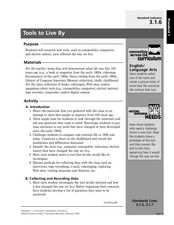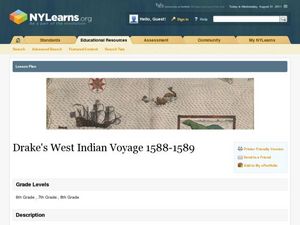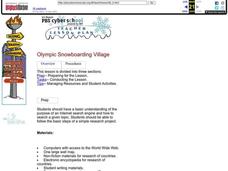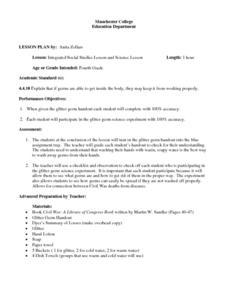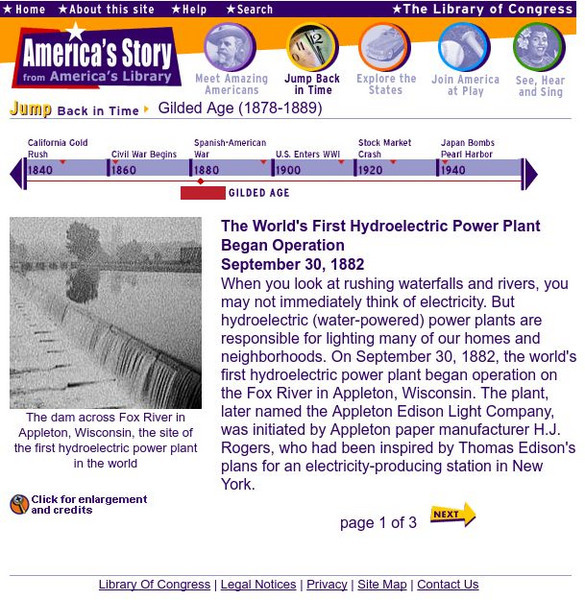Library of Congress
The Conservation Movement at a Crossroads: The Hetch Hetchy Controversy
Should wilderness areas be preserved or managed? Class members examine primary source documents, including lecture notes, articles, essays and congressional records to better understand the Hetch Hetchy controversy that created a split...
Teach Engineering
Earthquakes Living Lab: Geology and the 1906 San Francisco Earthquake
We can learn from the past to protect the future. Pairs look at two historical earthquakes: San Francisco, Calif., and Kobe, Japan. Pupils compare the two earthquakes and their impacts, then determine how engineers may use the...
Teach Engineering
Investigating Torque
Torque--a teachable moment? Here's a lesson on torque (or moment) and variables that include size, reinforcement, structural bracing, and material that affect torque.
Curated OER
Tools to Live By
Third graders compare life in the early 1900's with the life today. In this technology lesson, 3rd graders research about the development of a certain technological tool. They collect data and report findings in class.
Curated OER
Drake's West Indian Voyage 1588-1589
Middle schoolers investigate several maps detailing Sir Francis Drake's voyages. In this geography lesson, students practice reading maps and locating the precise locations of where Sir Francis Drake visited. Middle schoolers...
Curated OER
Cosmic Wheels
Students build a scale model of the Solar System and determine the time other planets take to travel around the Sun in comparison to the time of the Earth's revolution. The velocity of the planets are also determined in this lesson.
Curated OER
Inventions Change the World: The Enigma Machine
Third graders explore WWII by analyzing technological advances. In this invention instructional activity, 3rd graders discuss the use of the Enigma machine which decoded private German messages that communicated with U-boats. Students...
Curated OER
Conservation at a Crossroads Lesson 1: What Is Conservation and Why Does It Matter?
Students explore the concept of conservation. In this conservation lesson, students read articles and primary documents about the Conservation Movement in the United States and compare the movement to today's environmental movements....
Curated OER
Olympic Snowboarding Village
Students adopt a country to research and tour the country online. They plan a trip from Nagano back home to their country.
Curated OER
Inquiry and the Nature of Science
Students identify questions that can be answered through scientific investigations, design and conduct a scientific investigation. They also use appropriate tools and techniques to gather, analyze, and interpret data.
Curated OER
The Wrights' Flight: History Through Primary Sources
Students read primary source material about the Wrights' first flight such as a journal and a telegram. In this The Wrights' Flight lesson, students select the most reliable primary source and compare the pros and cons of using primary...
Curated OER
Eye Spy Science
Fourth graders identify the four kinds of violent storms. Using photographs, they create "eye spy" questions for each and mount them on construction paper. They write a brief summary for each photo and share the questions with the class...
Curated OER
Integrated Social Studies Lesson and Science Lesson
Fourth graders discuss the Civil War and the fact that many soldiers died during the war as a result of sickness. They discuss germs and participate in an activity that shows them how germs are spread and how they can be stopped from...
Library of Congress
Loc: Everyday Mysteries, Why Does Hair Turn Gray?
Explore the science behind gray hair through this summary produced by the Library of Congress.
Library of Congress
Loc: Everyday Mysteries Fun Science Facts
This resource is hosted by the Science and Technology Research Center of the Library of Congress. You are able to search the site to find answers to your science questions. The database of answers is composed of all questions asked of...
Library of Congress
Loc: Frederick Law Olmstead
Landscape architect, Frederick Law Olmstead, created Central Park, and helped with the preservation of Yosemite National Park and Niagara Falls. Discover this brief description of his life and work, and click through Olmsted's portrait...
Library of Congress
Loc: Everyday Mysteries: What Is Gps?
Where are you and where are you going? Visit this site and learn the discovery and purpose of GPS, Global Position Systems.
Library of Congress
Loc: Everyday Mysteries: What Is the Strongest Muscle?
There are a variety of ways one can look at what might be the strongest muscle in the body. This site defines the various types of muscles and goes on to explain which would be considered the strongest.
Library of Congress
Loc: Everyday Mysteries, What Are Stem Cells?
The buzz word "stem cells" are scientifically defined and the differences between stem cells and other cells explained in this "Everyday Mystery".
Smithsonian Institution
Lemelson Center: The Laser Turns 50
Follow the development of the laser from its earliest times to its many present day uses and forms.
Library of Congress
Loc: America's Story: San Francisco Earthquake
The 1906 earthquake in San Fransisco nearly wipes out the city. Read and view footage and information of this catastrophic event.
Library of Congress
Loc: America's Story: The World's 1st Hydroelectric Plant
This three-page article explores the operation of the first hydroelectric power plant and the spread of renewable energy in the United States.
Library of Congress
Loc: America's Story: Yellow Fever Cause Discovered
You have probably never heard of anyone you know having Yellow Fever. But in the early 1900s, it was mysterious as well as deadly. How was it transmitted? What did people do to try to prevent getting sick? Read the story at this site.
Library of Congress
Loc: Everyday Mysteries: Who "Invented" the Tv Dinner?
Ever wonder who "invented" the TV dinner? This article provides a discussion of the people and companies involved in the creation of complete frozen meals starting in the 1940s and ending in 1954 when Swanson's frozen meals appeared and...



